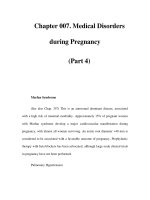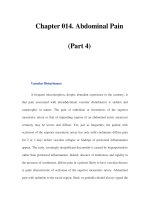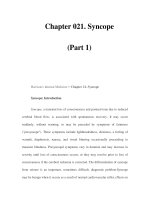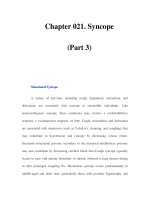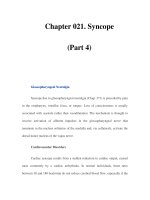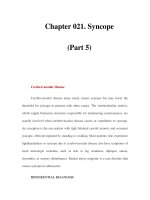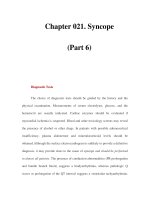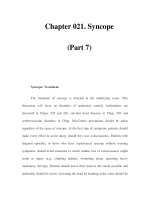Chapter 021. Syncope (Part 4) ppsx
Bạn đang xem bản rút gọn của tài liệu. Xem và tải ngay bản đầy đủ của tài liệu tại đây (57.74 KB, 5 trang )
Chapter 021. Syncope
(Part 4)
Glossopharyngeal Neuralgia
Syncope due to glossopharyngeal neuralgia (Chap. 371) is preceded by pain
in the oropharynx, tonsillar fossa, or tongue. Loss of consciousness is usually
associated with asystole rather than vasodilatation. The mechanism is thought to
involve activation of afferent impulses in the glossopharyngeal nerve that
terminate in the nucleus solitarius of the medulla and, via collaterals, activate the
dorsal motor nucleus of the vagus nerve.
Cardiovascular Disorders
Cardiac syncope results from a sudden reduction in cardiac output, caused
most commonly by a cardiac arrhythmia. In normal individuals, heart rates
between 30 and 180 beats/min do not reduce cerebral blood flow, especially if the
person is in the supine position. As the heart rate decreases, ventricular filling time
and stroke volume increase to maintain normal cardiac output. At rates <30
beats/min, stroke volume can no longer increase to compensate adequately for the
decreased heart rate. At rates greater than ~180 beats/min, ventricular filling time
is inadequate to maintain adequate stroke volume. In either case, cerebral
hypoperfusion and syncope may occur. Upright posture; cerebrovascular disease;
anemia; loss of atrioventricular synchrony; and coronary, myocardial, or valvular
disease all reduce the tolerance to alterations in rate.
Bradyarrhythmias (Chap. 225) may occur as a result of an abnormality of
impulse generation (e.g., sinoatrial arrest) or impulse conduction (e.g., AV block).
Either may cause syncope if the escape pacemaker rate is insufficient to maintain
cardiac output. Syncope due to bradyarrhythmias may occur abruptly, without
presyncopal symptoms, and recur several times daily. Patients with sick sinus
syndrome may have sinus pauses (>3 s), and those with syncope due to high-
degree AV block (Stokes-Adams-Morgagni syndrome) may have evidence of
conduction system disease (e.g., prolonged PR interval, bundle branch block).
However, the arrhythmia is often transitory, and the surface electrocardiogram or
continuous electrocardiographic monitor (Holter monitor) taken later may not
reveal the abnormality. The bradycardia-tachycardia syndrome is a common form
of sinus node dysfunction in which syncope generally occurs as a result of marked
sinus pauses, some following termination of paroxysms of atrial tachyarrhythmias.
Drugs are a common cause for bradyarrhythmias, particularly in patients with
underlying structural heart disease. Digoxin, β-adrenergic receptor antagonists,
calcium channel blockers, and many antiarrhythmic drugs may suppress sinoatrial
node impulse generation or slow AV nodal conduction.
Syncope due to a tachyarrhythmia (Chap. 226) is usually preceded by
palpitation or lightheadedness but may occur abruptly with no warning symptoms.
Supraventricular tachyarrhythmias are unlikely to cause syncope in individuals
with structurally normal hearts but may do so if they occur in patients with (1)
heart disease that also compromises cardiac output, (2) cerebrovascular disease,
(3) a disorder of vascular tone or blood volume, or (4) a rapid ventricular rate.
These tachycardias result most commonly from paroxysmal atrial flutter, atrial
fibrillation, or reentry involving the AV node or accessory pathways that bypass
part or all of the AV conduction system. Patients with Wolff-Parkinson-White
syndrome may experience syncope when a very rapid ventricular rate occurs due
to reentry across an accessory AV connection.
In patients with structural heart disease, ventricular tachycardia is a
common cause of syncope, particularly in those with a prior myocardial infarction.
Patients with aortic valvular stenosis and hypertrophic obstructive cardiomyopathy
are also at risk for ventricular tachycardia. Individuals with abnormalities of
ventricular repolarization (prolongation of the QT interval) are at risk to develop
polymorphic ventricular tachycardia (torsades des pointes). Those with the
inherited form of this syndrome often have a family history of sudden death in
young individuals. Genetic markers can identify some patients with familial long-
QT syndrome, but the clinical utility of these markers remains unproven. Drugs
(i.e., certain antiarrhythmics and erythromycin) and electrolyte disorders (i.e.,
hypokalemia, hypocalcemia, hypomagnesemia) can prolong the QT interval and
predispose to torsades des pointes. Antiarrhythmic medications may precipitate
ventricular tachycardia, particularly in patients with structural heart disease.
In addition to arrhythmias, syncope may also occur with a variety of
structural cardiovascular disorders. Episodes are usually precipitated when the
cardiac output cannot increase to compensate adequately for peripheral
vasodilatation. Peripheral vasodilatation may be appropriate, such as following
exercise, or may occur due to inappropriate activation of left ventricular
mechanoreceptor reflexes, as occurs in aortic outflow tract obstruction (aortic
valvular stenosis or hypertrophic obstructive cardiomyopathy). Obstruction to
forward flow is the most common reason that cardiac output cannot increase.
Pericardial tamponade is a rare cause of syncope. Syncope occurs in up to 10% of
patients with massive pulmonary embolism and may occur with exertion in
patients with severe primary pulmonary hypertension. The cause is an inability of
the right ventricle to provide appropriate cardiac output in the presence of
obstruction or increased pulmonary vascular resistance. Loss of consciousness is
usually accompanied by other symptoms such as chest pain and dyspnea. Atrial
myxoma, a prosthetic valve thrombus, and, rarely, mitral stenosis may impair left
ventricular filling, decrease cardiac output, and cause syncope.

